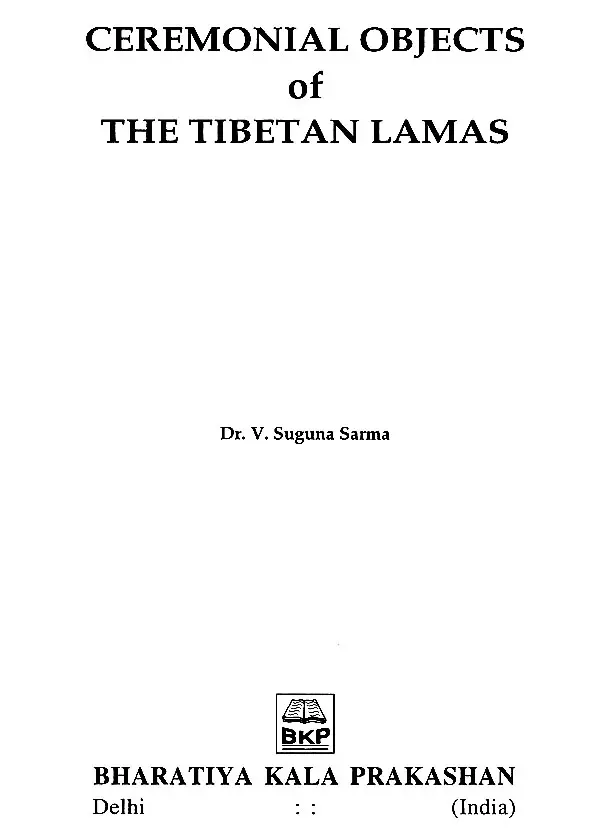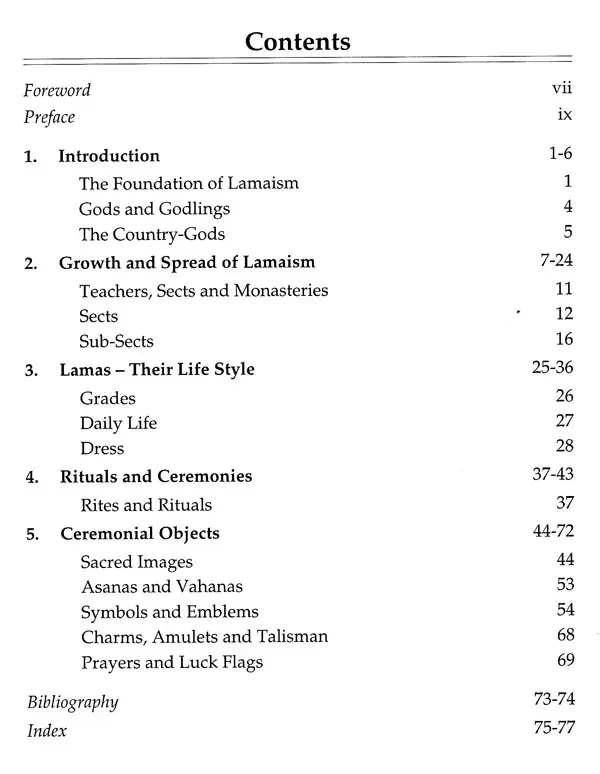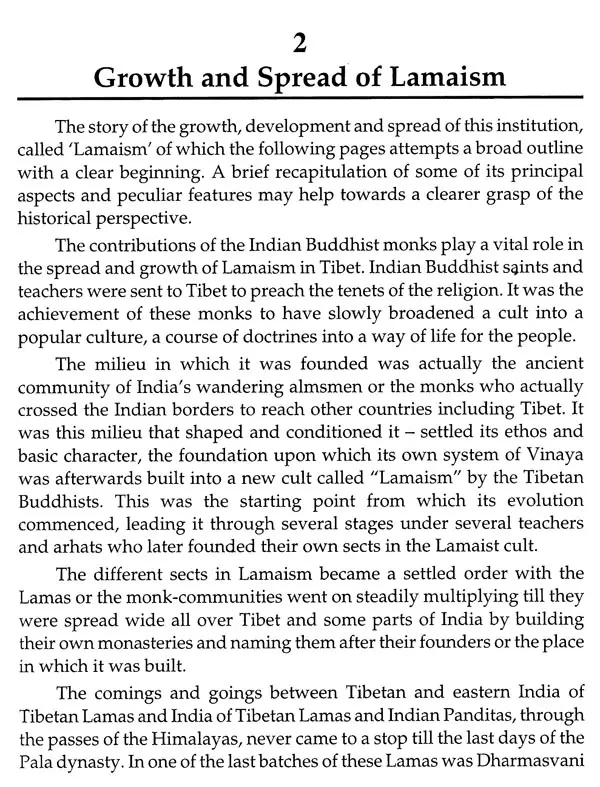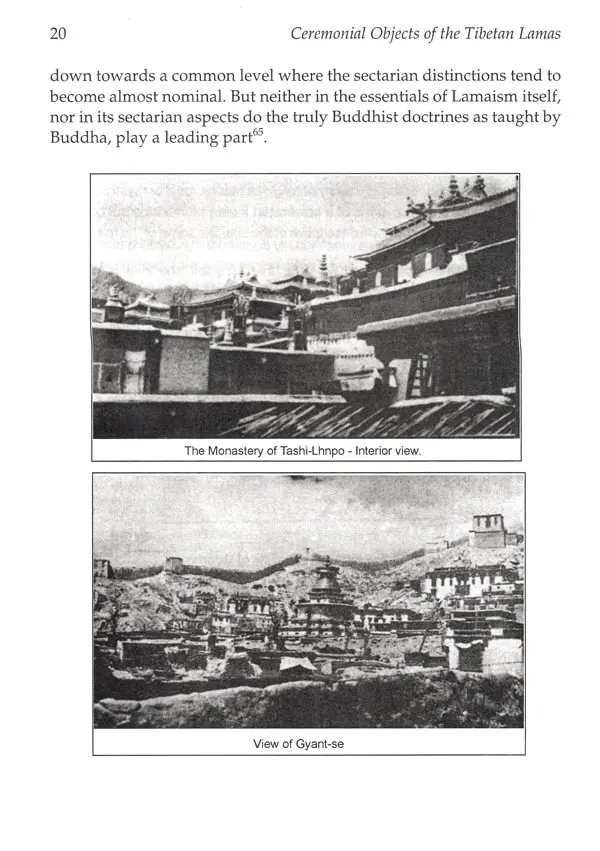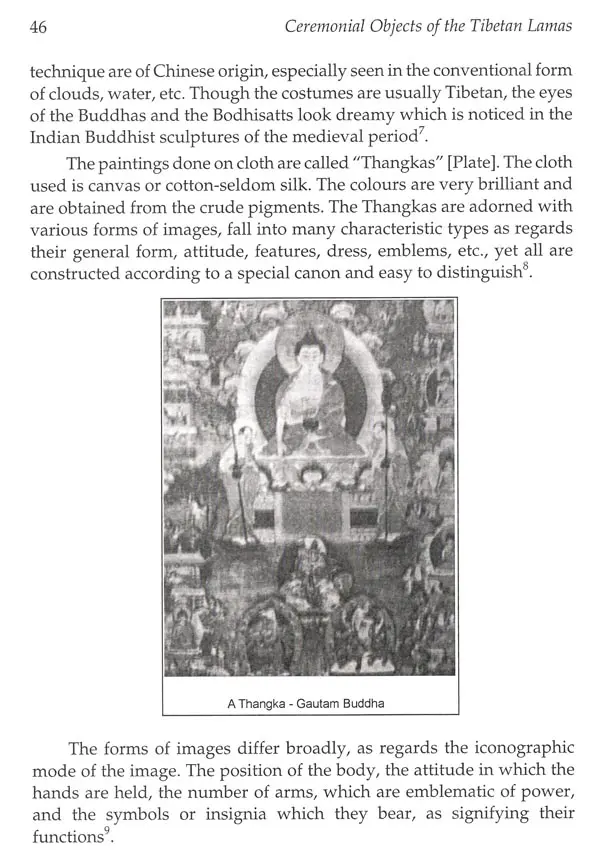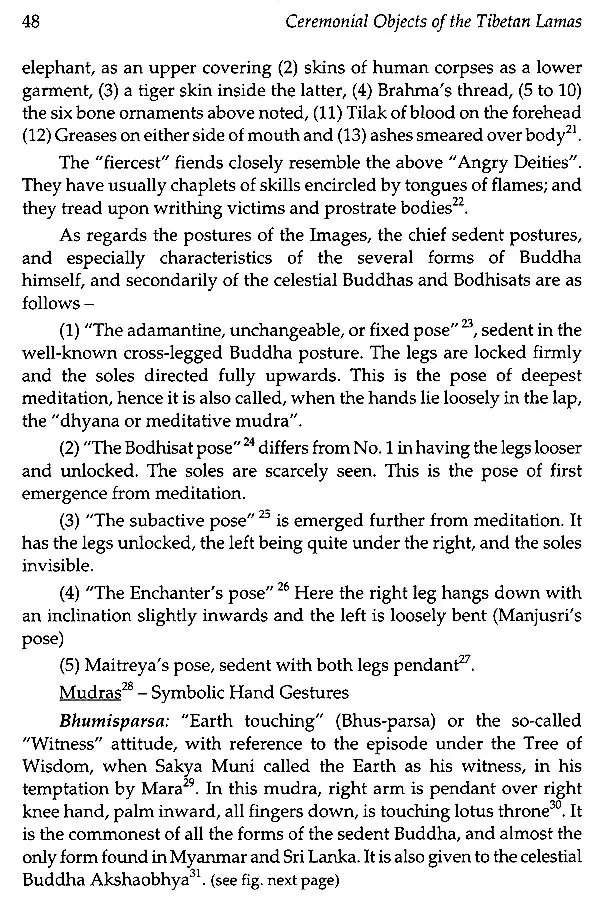
Ceremonial Objects of The Tibetan Lamas
Book Specification
| Item Code: | UAO074 |
| Author: | V. Suguna Sharma |
| Publisher: | Bharatiya Kala Prakashan |
| Language: | English |
| Edition: | 2016 |
| ISBN: | 9788180903946 |
| Pages: | 87 (Throughout B/w Illustrations) |
| Cover: | HARDCOVER |
| Other Details | 10.00 X 7.50 inch |
| Weight | 340 gm |
Book Description
The people of Tibet and their religion have been inseparable. Originally the Bon religion dominated Tibet. In the seventh century the Mahayana form of Buddhism was brought into Tibet by the two wives. of the Tibetan King Srong-tsan Llampo, along with the scared images and Sanskrit manuscripts, literature of the Tibetans One Guru Padmasambhava founded the "Lamaism" in Tibet, Tibetans Lamaism is a branch of Mahayana form of Buddhism and the study of Lamaism, its growth and spread is both fascinating and baffling.
The monasteries and temples conduct daily services during which the lamas officiate at the higher services held on certain days to commemorate special events in the life of Buddha and there are also services for Padmasambhava, the founder of Lamaism.
The objects used during the different ceremonies and rituals are of great interest and most of them are unknown to the outer world other than the Tibetans Hence this study, in which an attempt has been made to bring to light these rare specimens used by the lamas is their day to day rituals and on special occasions as well.
The present book "Ceremonial Objects of the Tibetan Lamas" consists of five chapters. The first chapter deals with the Origin foundation of Lamaism in Tibet. In the second chapter, the growth and spread of Lamaism, the teachers and saints who founded and propagated the different "Sects" and Monasteries of Lamaism are vividly described. The third chapter throws light on the lifestyle of a lama involving the various duties performed by him is his day to day life. In the fourth chapter some of the important rites and rituals, the chief ceremonies observed by the lamas are dealt in a detailed manner. Finally, the fifth chapter) discusses the mystic ceremonial objects used during the rituals performed by the Tibetan Lamas. The chapter begins with the description of the identification of the divinities and the images, their asana and mudras, the symbol and emblems, the talisman, amulets and charms, the different rosary types are also highlighted.
Dr. V. Suguna Sarma, Assistant Director in the Andhra Pradesh State Department of Archaeology & Museums, Hyderabad has had a brilliant academic career. She obtained M.A., M. Phil, and Ph.d degrees from Osmania University, Hyderabad. She is associated with several Academic bodies, Institutions and Universities as life member of Indian Art Historical Society and Andhra Pradesh History Congress. She is rendering services as external jury to Vishwa Bharati University, Shantiniketan, Bolpur (West Bengal) and is recognized as resource person of the Sri Potti Sri Ramulu Telugu University, Hyderabad.
She has attended several national and international seminars and presented informative research papers. She has also contributed several interesting Articles to well-known research Journals both within the Country and abroad.
The author has travelled widely within the country and also visited the north-eastern Himalayan belt-Nepal and Tibet in pursuit of Buddhist studies and brought out an interest publication on the Tibetan Thankas. The Subject of the present book 'Ceremonial Objects of the Tibetan Lamas' is the outcome of her journey into the land of the lamas. The other fascinating titles published by the author are 'Studies in Indian Textiles', 'History and Antiquites of Raichur Fort', Fabric Treasures of Andhra Pradesh', The Tibetan Thankas', Ikat Fabrics - A study' (in presso. She is continuing further research various fields of Arts, History and Archaeology.
The people of Tibet and their religion have been inseparable. Even in their earliest myths one finds references to Tibetan religious beliefs. Originally the Bon religion dominated Tibet and was a form of nature worship and demonolatry with human and animal sacrifices and all the rites of a primitive religion. In the seventh century the Mahayana form of Buddhism was brought into Tibet by the two wives of the Tibetan King Srong-tsan Gampo, along with the scared images and Sanskrit manuscripts from India. From then onwards Buddhism forms the essence of the life, culture and literature of the Tibetans. Later on, Guru Padmasambhava founded the "Lamaism" in Tibet, Tibetans Lamaism is a branch of Mahayana form of Buddhism and the study of Lamaism, its growth and spread is both fascinating and baffling.
The number of Gods in the Tibetan pantheon is legion. Some of these divinities are in human form and have their origin is history, legend, or sometimes pure imagination. Every image is symbolic of something, and every part of an image has a meaning which cannot be known even to those deeply initiated in to the mysteries of Lamaism.
The monasteries and temples conduct daily services during which the lamas officiate at the higher services held on certain days to commemorate special events in the life of Buddha and there are also services for Padmasambhava, the founder of Lamaism. There are special invocations to the tutelary gods and certain daily ceremonial services and rites to the laity. All these are accompanied by special dress and rites with music and offerings to the numerous divinities as per the requirement. The objects used during the different ceremonies and rituals are of great interest and most of them are unknown to the outer world other than the Tibetans. Hence this study, in which an attempt has been made to bring to light these rare specimens used by the lamas is their day to day rituals and on special occasions as well.
To find that this book 'Ceremonial Objects of the Tibetan Lamas' is by an Indian author, Dr. Suguna Sarma, is both surprising and satisfying. Scholars in India have very little chance to study first hand this mystifying and serene art, for objects of Tibetan art have not yet found much space in museums in India and since visiting Tibet, where the objects are still in use, is rather impossible, and to study them is possible only at the museums in USA and Europe, where they have been seriously collected. However, the author, Suguna Sarma, visited the north-east region of India as well as Nepal and Tibet, where these objects are still in use by the local lamas and the local monasteries. The inspiration she drew from there and the information fshe collected during her visit to those places has been shared by her in five chapters of this book. As the contents of this book will show, she has covered all aspects of Tibetan Lamaism, the Country, the Gods and God lings, the growth and spread of Lamaism in Tibet, its link with Inida, various aspects of the life of Lamas, their rituals, and more importantly, the sacred sculptures they use in metal and other materials, miscellaneous ritual objects and Thangkas (the painted banners on cloth). The history of Thangka paintings, the most significant and charming among these ritual objects, stretches from the elevenths to the present times. Apart from these, bronze statues used as ritual objects are also among the most beautiful and powerful sculptures in Asia. Dr. Suguna Sarma has carefully identified them, and very clearly described these objects. I am sure this book, like her previous books, "Fabric Treasures of Andhra Pradesh", "History and antiquities of Raichur Fort", and "The Tibetan Thangkas" will be welcomed by scholars, students and museum curators. I wish her success in her future writing endeavors, and will look forward to see more of her books in coming years.
The Foundation of Lamaism
About 2500 years ago Buddhism was born in our country as a philosophy. Since then it has been transferred into a religion and has travelled to different lands, having assumed different characteristics and different sects in different countries. Buddha was born in India in the Sixth Century B.C., the Century in which he was born was full of extra ordinary intellectual genius borne of discovery for every ancient civilization. Buddhism passed beyond India's frontiers into Tibet, Mongolia, China, Korea, Japan, Sri Lanka and many other countries to become one of the world's great religions which believed in goodness produced by all other religions.Buddha as the central figure of the system, soon became invested with supernatural and legendary attributes. And as the religion extended its range and influence, and enjoyed princely patronage and ease, it became more meta-physical and ritualistic. Primitive Buddhism practically confined its salvation to a select few, but the Mahayana extended salvation to the entire Universe.
Tibet, at the beginning of the Seventh Century, though now surrounded by Buddhist countries, knew nothing of that religion, and was still buried in barbaric darkness. Not until about the year 640 A.D. did it first receive the Buddhism, and through it some beginnings of civilization among its people. But here it is necessary to refer to the changes in the Form which Buddhism meanwhile had undergone in India. Book's Contents and Sample Pages
